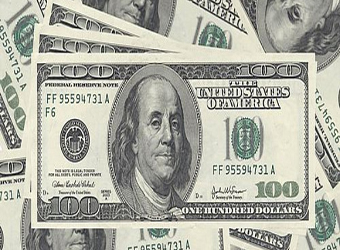The dollar hovered Thursday near a seven-week high on increasing signs given by U.S. Federal Reserve officials that the U.S. central bank is seriously considering raising interest rates this month.
Federal Reserve Governor Lael Brainard said late on Wednesday an improving global economy and a solid U.S. recovery mean it will be “appropriate soon” for the Fed to raise rates.
The dollar index, which measures the greenback against a basket of six major currencies, was slightly higher at 101.91. The index climbed to 101.97 on Wednesday, its highest since Jan. 11.
On Tuesday, two influential Fed policymakers, William Dudley and John Williams, encouraged dollar bulls with comments that suggested rate-setters are worried about waiting too long in the face of pending economic stimulus from Washington.
“The Fed is likely to raise interest rates this month unless the U.S. jobs data due next week is bad,” said Yukio Ishizuki, FX strategist at Daiwa Securities in Tokyo.
Futures traders are now pricing in a 66 percent chance of a Fed hike in March, up from 35 percent on Wednesday, according to the CME Group’s FedWatch Tool.
U.S. President Donald Trump’s long-awaited speech on Tuesday failed to give specific details on his economic plans, but outlined broad tax cuts and a $1 trillion public-private initiative to rebuild degraded roads and bridges.
“Investors liked that Trump was behaving well during his speech although it lacked specifics in policies,” said Daiwa’s Ishizuki.
Against its Japanese counterpart, the dollar was up 0.3 percent at 114.04 yen. The greenback reached a two-week high of 114.16 yen earlier in the day.
A widening of U.S.-Japan interest rate differentials helped the dollar, as U.S. Treasury yields jumped on an increased prospect for a March rate hike.
The U.S. two-year yield hovered near a more than seven-year high of 1.308 percent touched on Wednesday. The benchmark 10-year Treasury yield was also close to a two-week high, last standing at 2.461 percent.
However, some analysts warned that the dollar could weaken despite the widening interest rate differentials should stocks retreat.
“If the Fed goes ahead with a faster pace of rate hikes and shrinks its balance sheet, it will weigh on stock prices,” said Minori Uchida, chief FX analyst at Bank of Tokyo Mitsubishi UFJ.
“Lower share prices and wider yield differentials would result in a weaker dollar, just like in May 2013 when Fed’s Bernanke signalled tapering,” said Uchida.
Investors are closely watching speeches from Fed Chair Janet Yellen and Vice Chair Stanley Fischer on Friday for further policy clues.
The U.S. non-farm payrolls next Friday is another crucial factor to decide on the possibility of a March rate hike.
Sterling and the Canadian dollar weakened against the greenback to their lowest levels since Jan. 20.
Canada’s central bank held rates steady on Wednesday, striking a cautious tone on the “significant uncertainties” facing the economy.
The greenback hovered near a six-week high versus the loonie, last standing at 1.3356 Canadian dollar.
Sterling sank to a six-week low of $1.2261 as disappointing economic data on Wednesday added to political nerves that have begun to weigh on the currency again after last year’s Brexit vote.
The euro was down 0.2 percent at $1.0529. The common currency dipped to a one-week low of $1.0514 against the dollar on Wednesday.
The Australian dollar sagged on weaker-than-expected trade data, dipping 0.3 percent to $0.7654.
Australia’s trade surplus shrank unexpectedly in January, though the quarterly current account might still edge into the black for the first time since the mid-1970s.
Source: Reuters


